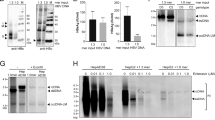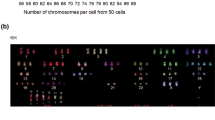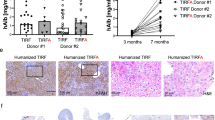Abstract
Our previous studies suggest that replication-defective Sindbis vectors might be promising agents for specific tumor targeting and detection. However, the effects of innate and/or adaptive anti-viral immunity, in particular, the IFN-I/STAT1 signaling pathway, may impact their therapeutic potential. Using a bioluminescent imaging system, we demonstrate that although most normal cells are not permissively transduced by replication-defective Sindbis vector, transduction of liver non-sinusoidal endothelial occurs the first time IFN-I/STAT1 signaling deficient mice are inoculated with the vector. Transduction of some cells is not surprising since STAT1 knockout animals show significant delay in IFN responses such as the production of IFN-α/β and transcriptional activation of several anti-viral genes (IRF7, RIG-I, PKR, TLR3, USP18, ISG15). However, beyond the initial vector transduction, which resolves rapidly, secondary inoculums of Sindbis vectors do not transduce any liver cells, suggesting that an alternative antiviral pathway may protect against further transduction. Other known signaling pathways were examined using mice lacking functional TLR3, tumor necrosis factorαR or nuclear factor-kappa B (p50). Surprisingly, none of those pathways seem to play a significant role in anti-Sindbis responses. Thus it appears that in vivo, in contrast to the ready transduction of tumor cells, transduction of normal cells by replication-defective Sindbis vector is limited, possibly by a novel mechanism.
This is a preview of subscription content, access via your institution
Access options
Subscribe to this journal
Receive 12 print issues and online access
$259.00 per year
only $21.58 per issue
Buy this article
- Purchase on Springer Link
- Instant access to full article PDF
Prices may be subject to local taxes which are calculated during checkout




Similar content being viewed by others
References
Hacein-Bey-Abina S, Von Kalle C, Schmidt M, McCormack MP, Wulffraat N, Leboulch P et al. LMO2-associated clonal T cell proliferation in two patients after gene therapy for SCID-X1. Science 2003; 302: 415–419.
Tseng JC, Hurtado A, Yee H, Levin B, Boivin C, Benet M et al. Using sindbis viral vectors for specific detection and suppression of advanced ovarian cancer in animal models. Cancer Res 2004; 64: 6684–6692.
Tseng JC, Zanzonico PB, Levin B, Finn R, Larson SM, Meruelo D . Tumor-specific in vivo transfection with HSV-1 thymidine kinase gene using a Sindbis viral vector as a basis for prodrug ganciclovir activation and PET. J Nucl Med 2006; 47: 1136–1143.
Kurkela S, Manni T, Myllynen J, Vaheri A, Vapalahti O . Clinical and laboratory manifestations of Sindbis virus infection: prospective study, Finland, 2002–2003. J Infect Dis 2005; 191: 1820–1829.
Strauss JH, Wang KS, Schmaljohn AL, Kuhn RJ, Strauss EG . Host-cell receptors for Sindbis virus. Arch Virol Suppl 1994; 9: 473–484.
Wang KS, Kuhn RJ, Strauss EG, Ou S, Strauss JH . High-affinity laminin receptor is a receptor for Sindbis virus in mammalian cells. J Virol 1992; 66: 4992–5001.
Menard S, Tagliabue E, Colnaghi MI . The 67 kDa laminin receptor as a prognostic factor in human cancer. Breast Cancer Res Treat 1998; 52: 137–145.
Aznavoorian S, Murphy AN, Stetler-Stevenson WG, Liotta LA . Molecular aspects of tumor cell invasion and metastasis. Cancer 1993; 71: 1368–1383.
Liotta LA . Tumor invasion and metastases – role of the extracellular matrix: Rhoads Memorial Award lecture. Cancer Res 1986; 46: 1–7.
Tseng JC, Levin B, Hirano T, Yee H, Pampeno C, Meruelo D . In vivo antitumor activity of Sindbis viral vectors. J Natl Cancer Inst 2002; 94: 1790–1802.
Tseng JC, Levin B, Hurtado A, Yee H, Perez de Castro I, Jimenez M et al. Systemic tumor targeting and killing by Sindbis viral vectors. Nat Biotechnol 2004; 22: 70–77.
Jan JT, Griffin DE . Induction of apoptosis by Sindbis virus occurs at cell entry and does not require virus replication. J Virol 1999; 73: 10296–10302.
Levine B, Huang Q, Isaacs JT, Reed JC, Griffin DE, Hardwick JM . Conversion of lytic to persistent alphavirus infection by the bcl-2 cellular oncogene. Nature 1993; 361: 739–742.
Bredenbeek PJ, Frolov I, Rice CM, Schlesinger S . Sindbis virus expression vectors: packaging of RNA replicons by using defective helper RNAs. J Virol 1993; 67: 6439–6446.
Levy DE, Garcia-Sastre A . The virus battles: IFN induction of the antiviral state and mechanisms of viral evasion. Cytokine Growth Factor Rev 2001; 12: 143–156.
Ryman KD, Klimstra WB, Nguyen KB, Biron CA, Johnston RE . Alpha/beta interferon protects adult mice from fatal Sindbis virus infection and is an important determinant of cell and tissue tropism. J Virol 2000; 74: 3366–3378.
Shresta S, Sharar KL, Prigozhin DM, Snider HM, Beatty PR, Harris E . Critical roles for both STAT1-dependent and STAT1-independent pathways in the control of primary dengue virus infection in mice. J Immunol 2005; 175: 3946–3954.
Byrnes AP, Griffin DE . Binding of Sindbis virus to cell surface heparan sulfate. J Virol 1998; 72: 7349–7356.
Klimstra WB, Ryman KD, Johnston RE . Adaptation of Sindbis virus to BHK cells selects for use of heparan sulfate as an attachment receptor. J Virol 1998; 72: 7357–7366.
Prakash A, Smith E, Lee CK, Levy DE . Tissue-specific positive feedback requirements for production of type I interferon following virus infection. J Biol Chem 2005; 280: 18651–18657.
Gorchakov R, Frolova E, Williams BR, Rice CM, Frolov I . PKR-dependent and -independent mechanisms are involved in translational shutoff during Sindbis virus infection. J Virol 2004; 78: 8455–8467.
Berlanga JJ, Ventoso I, Harding HP, Deng J, Ron D, Sonenberg N et al. Antiviral effect of the mammalian translation initiation factor 2alpha kinase GCN2 against RNA viruses. EMBO J 2006; 25: 1730–1740.
Paladino P, Cummings DT, Noyce RS, Mossman KL . The IFN-independent response to virus particle entry provides a first line of antiviral defense that is independent of TLRs and retinoic acid-inducible gene I. J Immunol 2006; 177: 8008–8016.
Bello MJ, de Campos JM, Kusak ME, Vaquero J, Sarasa JL, Pestana A et al. Molecular analysis of genomic abnormalities in human gliomas. Cancer Genet Cytogenet 1994; 73: 122–129.
Linge C, Gewert D, Rossmann C, Bishop JA, Crowe JS . Interferon system defects in human malignant melanoma. Cancer Res 1995; 55: 4099–4104.
Lu R, Au WC, Yeow WS, Hageman N, Pitha PM . Regulation of the promoter activity of interferon regulatory factor-7 gene. Activation by interferon snd silencing by hypermethylation. J Biol Chem 2000; 275: 31805–31812.
Sun WH, Pabon C, Alsayed Y, Huang PP, Jandeska S, Uddin S et al. Interferon-alpha resistance in a cutaneous T-cell lymphoma cell line is associated with lack of STAT1 expression. Blood 1998; 91: 570–576.
Wong LH, Krauer KG, Hatzinisiriou I, Estcourt MJ, Hersey P, Tam ND et al. Interferon-resistant human melanoma cells are deficient in ISGF3 components, STAT1, STAT2, and p48-ISGF3gamma. J Biol Chem 1997; 272: 28779–28785.
Stojdl DF, Lichty B, Knowles S, Marius R, Atkins H, Sonenberg N et al. Exploiting tumor-specific defects in the interferon pathway with a previously unknown oncolytic virus. Nat Med 2000; 6: 821–825.
Stojdl DF, Lichty BD, tenOever BR, Paterson JM, Power AT, Knowles S et al. VSV strains with defects in their ability to shutdown innate immunity are potent systemic anti-cancer agents. Cancer Cell 2003; 4: 263–275.
Acknowledgements
We thank Dr Christine Pampeno for critical reading of this manuscript and helpful discussions. This study was supported by US Public Health Service grants CA100687, and CA68498 from the National Cancer Institute, National Institutes of Health, and Department of Health and Human Services and Northeast Biodefense Center U54-AI057158-Lipkin, and AI28900 from NIAID.
Author information
Authors and Affiliations
Corresponding author
Rights and permissions
About this article
Cite this article
Tseng, JC., Zheng, Y., Yee, H. et al. Restricted tissue tropism and acquired resistance to Sindbis viral vector expression in the absence of innate and adaptive immunity. Gene Ther 14, 1166–1174 (2007). https://doi.org/10.1038/sj.gt.3302973
Received:
Revised:
Accepted:
Published:
Issue Date:
DOI: https://doi.org/10.1038/sj.gt.3302973
Keywords
This article is cited by
-
Molecular and metabolic pathways mediating curative treatment of a non-Hodgkin B cell lymphoma by Sindbis viral vectors and anti-4-1BB monoclonal antibody
Journal for ImmunoTherapy of Cancer (2019)
-
Controlled propagation of replication-competent Sindbis viral vector using suicide gene strategy
Gene Therapy (2009)



